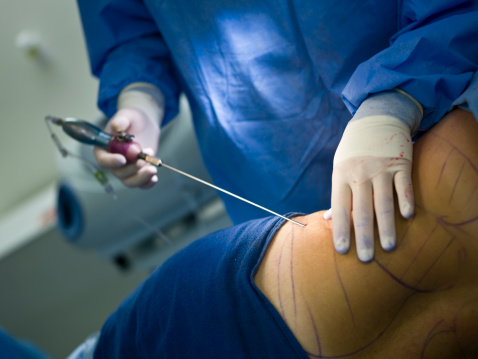
Liposuction is also known as liposculpture suction or lipectomy. It’s a form of cosmetic surgery that removes fat from the body.
It’s often used to treat the abdomen, thighs and buttocks, neck and chin, upper and lower arms, calves and back.
A hollow instrument known as a “cannula” is used to remove the fat. This is placed under the skin. The cannula is then subjected to a powerful vacuum.
Here are some facts about liposuction
These are the key points to remember about liposuction. The main article provides more information.
- General anesthesia is used to perform the operation.
- Although liposuction does not help with weight loss, it is a cosmetic procedure that has subtle effects.
- Scarring and infection are possible.
- Some medical conditions can be treated with liposuction.
Uses
People would likely achieve similar or better results if they lived a healthy lifestyle that included regular exercise, a balanced diet and good sleep habits.
Each fat cell in a person’s body grows in size and volume when they gain weight. The number of fat cells in a single area can be reduced by liposuction.
Before deciding whether to undergo liposuction, it is important that people discuss the pros and con of the procedure with their doctor.
The results are subtle, not dramatic.
These body areas are often targeted for liposuction:
- Abdomen
- Back
- Buttocks
- Chest
- inner knees
- Hips
- Flanches (love handles).
- The neckline and the area below the chin
- Thighs, both “saddlebags,” which are the outer thighs and inner thighs.
- upper arms
People with good skin texture and elasticity are best candidates for liposuction. The skin will mold to new contours naturally.
Patients with a lack of elasticity can have loose skin around the areas where the procedure was performed.
Those with circulation or blood flow problems, such as coronary artery disease, swelling or edema. A person must be at least 18 years old and in good physical health.
- Gynecomastia – Sometimes fat builds up under a man’s breasts.
- Lipodystrophy Syndrome – Body fat accumulates in one area and is then lost in another. By distributing body fat more naturally, liposuction can help improve patient’s appearance.
- Extreme weight loss due to obesity – Someone with morbid obesity may need treatment for excess skin or other abnormalities.
Operation
Patients will need to have some tests done before the operation to make sure they are healthy.
These are some possible recommendations.
- Regular aspirin or anti-inflammatory drugs should be stopped at least two weeks prior to surgery.
- Women might be asked to discontinue using the contraceptive pill.
- Iron supplements may be recommended for patients suffering from anemia.
- A consent form will be signed by the individual. This is to confirm that the individual is fully aware of all the benefits and risks involved in the procedure.
After liposuction
- Anesthesia: People who receive a general anesthetic typically spend the night in hospital. People who received a local anesthetic might be able leave the hospital that same day.
- Support bandages A support corset or bandage will be used to cover the area.
- Antibiotics These can be given right after the operation.
- Painkillers : Analgesics are able to relieve pain and inflammation.
- Stitches In a follow-up appointment, the surgeon will remove any stitches.
- Bruising In the area targeted, significant bruising could occur.
- Numbness It is possible to feel numb in the area of fat removal. This should resolve in 6-8 weeks.
Results
People who had previously experienced fat accumulation in their hips may find that their buttocks are now the problem. People who gain weight may notice a shift in their fat distribution.
The effects of liposuction won’t be evident until inflammation has subsided. If fat has been removed, the area will appear smaller.
Risques
Major surgery can result in bleeding, infection and adverse reactions to anesthesia.
Risks of complications are usually related to the size of the procedure and the surgeon’s specific training.
These risks, side effects or complications can be dangerous.
- Severe bruising can last several weeks.
- Inflammation: It may take up 6 months for swelling to subside. Fluid may also continue to leak from the incisions.
- Thrombophlebitis is a blood clot that forms in a vein. This can cause inflammation and other complications.
- Uneven contours: Skin may look wavy, bumpy, or withered if it has poor skin elasticity or if the wound heals in an irregular way.
- Numbness: Although the affected area may feel numb for some time, this is usually temporary.
- Infections: A rare case of skin infection after liposuction is possible. This may require surgery to correct the problem.
- It is rare to have internal organ punctures.
- Death: There is a very small chance of dying from anesthesia.
- Kidney and heart problems: Fluids being injected or suctioned can cause fluid changes that could lead to kidney or heart problems.
- Pulmonary embolism is when fat gets in the blood vessels and travels to your lungs. This can cause a blockage of circulation. This could be life-threatening.
- Pulmonary edema is when fluid is injected into the bloodstream and accumulates in the lungs.
- Allergy: Patients may react to medication or other materials during surgery.
- Skin burns: Cannula movements can cause skin friction or nerve damage.
People who carefully consider the pros and cons before deciding on a surgeon are more likely to be satisfied. You can visit www.chicagoliposuction.com for more details and get relevant information that you need about Liposuction.

